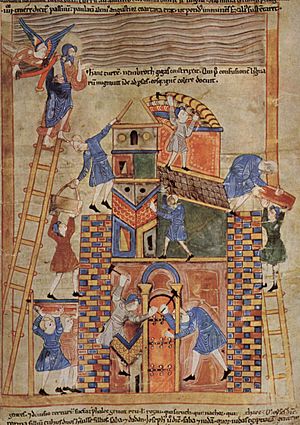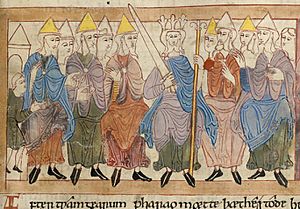Old English Hexateuch facts for kids

The Old English Hexateuch is a special collection of books from the Old Testament that were translated into Old English. This happened a long time ago, during the late Anglo-Saxon period. It was a big team effort, and a wise scholar named Ælfric of Eynsham probably led the project.
This was the very first time the first six books of the Old Testament were translated into English! These books are:
These translations were likely made so that everyday people, not just priests, could understand these important stories.
We know about this translation from seven old handwritten copies, called manuscripts. Most of these copies are not complete. The most famous one is a beautiful book with many pictures, kept at the British Library. It's known as Cotton MS Claudius B.iv. Another copy, which doesn't have as many pictures but also includes the Book of Judges, is called the Old English Heptateuch. You can find it in Oxford.
You can even see the whole Cotton Claudius B.iv manuscript online on the British Library website!
The Famous Cotton Claudius B.iv Manuscript
The Cotton Claudius B.iv manuscript was probably put together around the early 1000s at St Augustine's Abbey in Canterbury. It includes some translations and an introduction written by Ælfric of Eynsham. Other parts of the translation were done by people whose names we don't know.
This manuscript is mostly complete, with 156 pages (called folios). However, it doesn't contain every single word from the original Bible books. Later, in the 1100s, more notes and comments in Latin and Old English were added. These were often written in empty spaces next to the pictures.
Amazing Illustrations
One or more artists created 394 drawings for this manuscript. These drawings use different colored inks and often have bright washes of color. They show about 550 different scenes from the Bible stories. Many of these pictures were never fully finished.
What's really cool is that the artists didn't try to show how people lived in ancient times. Instead, they drew the scenes as if they were happening in Anglo-Saxon England! This gives us a fantastic look at what life was like for Anglo-Saxons. The many pictures suggest that the book was made for ordinary people to enjoy and learn from. It's the earliest illustrated manuscript of a large part of the Bible in any everyday language.
There are twelve pictures that take up a whole page. Other pictures range from almost a full page to about a quarter of a page. Many pages have two or even three illustrations. Most pages have at least one picture. Some pictures even combine two scenes in different sections. As you go through the book, the pictures tend to have less color added.
The coloring in the manuscript has some unique features. For example, many people have blue hair! Also, many tents are shown with bold, colorful stripes. The artists often took chances to draw groups of animals when the text mentioned them. You can also frequently spot the Hand of God appearing in the scenes.
The pages of the manuscript are about 32.5 cm by 21.5 cm (about 12.8 by 8.5 inches). The text itself covers an area of about 26 cm by 16 cm (about 10.2 by 6.3 inches). This important book became part of the Cotton Library by the year 1621.
See also
- Wessex Gospels


